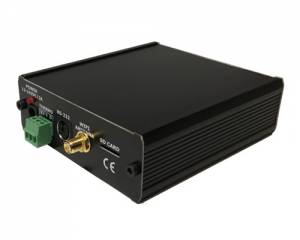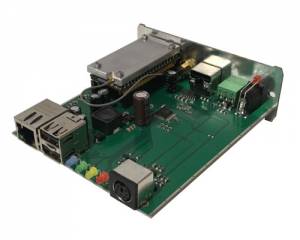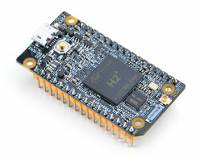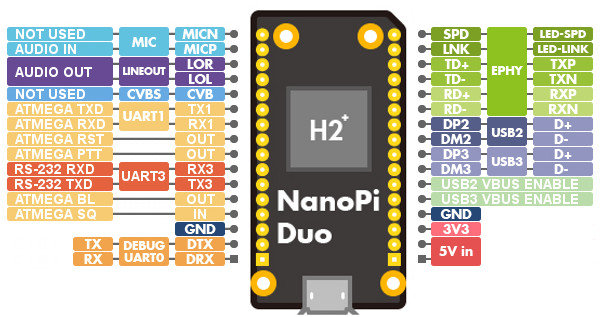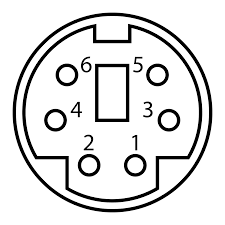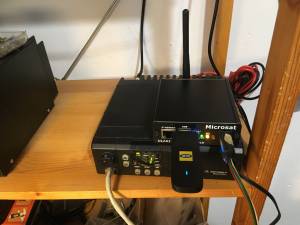[Update 15 May 2021] ULARI Radio Interface device was discontinued because the manufacturer of Linux-based boards for these devices (NanoPi Duo modules) stopped manufacturing them without any earlier notice. Please check out my ULARI ECO Radio Interface for similar functionality.
ULARI Radio Interface Hardware
ULARI Radio Interface is based on NanoPi Duo 256 MB module from FriendlyARM. The device consists of a microprocessor module and a motherboard with all necessary external components. The whole system includes:
- Radio 6-pin minidin connector (Microsat standard, WX3in1-like pinout),
- A 100 Mbit Ethernet connector with surge protectors,
- Two USB connectors with surge protectors, 5V/1A total current consumption (suitable for moderm LTE modems),
- Wifi chip with external antenna,
- RS-232 serial port (via 6-pin minidin connector),
- DS18B20 thermometer connector,
- Four leds informing about device operation,
- SD CARD connector for operating system image.
This is not a standalone radio transceiver. You need a proper VHF or UHF amateur radio station to use the device for packet transmission and reception.
Technical parameters
- Dimensions (without connectors): 100x94x32mm,
- Weight: 240g
- Housing material: aluminium, PCB panels,
- Radio connector: minidin 6-pin female (WX3in1-compatible cables),
- Wifi connector: SMA female (antenna included),
- Power connector: round 5.5/2.1mm (with plus at center),
- Thermometer connector: terminal with screws,
- Serial port connector: minidin 6-pin female (1 serial port),
- Supply voltage: 8-14 VDC,
- Power consumption (at 12V): 150mA (*)
(*) Ethernet connected, Wifi disabled, no USB and serial current sink, direwolf daemon running with default settings.
ULARI Radio Interface photos
Radio 6-pin minidin socket is connected to microprocessor audio peripheral via a suitable analog frontend including necessary signal filtering, amplification and high frequency supression.
NanoPi Duo pinout
Rear panel RS-232 port pinout
RS-232 port can be used to connect any serial port devices with RS-232 voltage levels. Devices with low current consumption can also be powered from this connector. GPS-RS232/Microsat/2 is compatible and works nice.
- Pin 1 – 5V output, do not short-circuit, max. current 100mA,
- Pin 2 – GND,
- Pin 3 – hard-wired to negative voltage for WS-2300/WS-2350 weather station support,
- Pin 4 – RS-232 Port 2 TXD,
- Pin 5 – RS-232 Port 2 RXD,
- Pin 6 – not used.
Front panel RADIO port pinout
RADIO port pinout is the same as in Microsat WX3in1 and PLXTracker/PLXDigi line of devices. Cables can be used interchangeably.
- Pin 1 - not connected,
- Pin 2 - APRS audio output from the device to the microphone input of the radio. This output also acts as a PTT by shorting pin to ground through a 2k2 resistor - an option for portable radios that do not have a separate PTT input (selectable in configuration software, 2k2 resistor is built-in),
- Pin 3 - not connected,
- Pin 4 - APRS audio input from radio to WX3in1,
- Pin 5 - Ground pin,
- Pin 6 - PTT output - if the external PTT output is selected in device configuration, this pin is shorted to ground while broadcasting.
ULARI test equipment
As an example of an operational ULARI Radio Interface device let's look at my test equipment:
And some details about the equipment:
- This ULARI Radio Interface connects to Motorola GM-300 via front panel mic/speaker connector,
- It acts as an I-Gate,
- It connects to the internet via Huawei E3372h-153 modem in hi-link mode (hi-link modems show as a virtual USB network card for operating system, which simplifies things a lot),
- It acts as a Wifi access-point for my workshop, providing internet connection via LTE modem,
- Despite of the fact that 3G/LTE modems don't have a public IP in Poland, it is accessible from every place in a world thanks to OpenVPN technology working on top of Linux operating system.
ULARI as an APRS Tracker
And with a little more command-line work and my GPS-RS232/Microsat/2 receiver connected to rear panel RS-232 port, it can also become:
- An APRS Tracker with Smartbeaconing (more info here: GPS and APRS Tracker settings).

